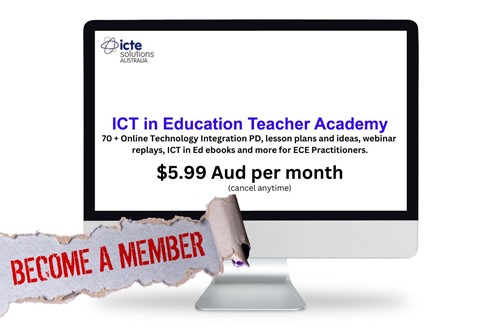Welcome to my page that will highlight the best strategies for you to learn how to integrate technology in the classroom.
The role of integrating technology in classroom practices is a complex but potentially powerful tool. However, if you are to effectively integrate technology in teaching and learning rather than add it on as an extra activity, then you will need a good understanding of ICT concepts and their relation to other areas of the curriculum.
The key to successful technology integration in the classroom is not the latest and greatest technologies, nor the best practices that you may read about elsewhere, it is YOU!
You are the key as technology integration in the classroom is an instructional choice that will always require your careful and considerate planning. While you might read about how different technologies can be integrated, only you know what is available in your own teaching and learning environment.
Integrating technology in education is about exploiting the available technology in the classroom. The here and now of the available technology. What you read comes from other people’s imagination in relation to their own available technology. You might have these available, but you know your students best and this is what being an ICT capable teacher is.

As a member of our ICT in Education Teacher Academy you will develop an understanding and judgement about how to use your available technology in the classroom.
Complex and continual technology integration professional development is the crucial element to your success. You will gain the expertise you need such as:
- How to integrate ICT in early childhood education.
- How to integrate technology in the science classroom.
- How to integrate ICT in teaching maths.
- How to support literacy with ICT integrated lesson plans.
ACCESS THESE ONLINE ICT WORKSHOPS FOR TEACHERS NOW $5.99 per month (cancel anytime)

What are the benefits of technology integration in the classroom?
There are many reasons why integrate technology in the classroom. Here are some that I listed in an earlier article.
- E-learning or Online Learning: The presence of ICT in education allows for new ways of learning for students and teachers. E-learning or online learning is becoming increasingly popular and with various unprecedented events taking place in our lives, this does not only open opportunities for schools to ensure that students have access to curriculum materials whilst in the classroom but also allows them to ensure students outside the classroom such as at home or even in hospitals can learn.
- ICT brings inclusion: The benefits of ICT in education is of such that students in the classroom can all learn from the curriculum material. Students with special needs are no longer at a disadvantage as they have access to essential material and special ICT tools can be used by students to make use of ICT for their own educational needs. Despite this, it opens up new issues related to the 'digital divide' and providing access to ICT tools and resources for those who are less fortunate.
- ICT promotes higher-order thinking skills: One of the key skills for the 21st century which includes evaluating, planning, monitoring, and reflecting to name a few. The effective use of ICT in education demands skills such as explaining and justifying the use of ICT in producing solutions to problems. Students need to discuss, test, and conjecture the various strategies that they will use.
- ICT enhances subject learning: It is well known these days that the use of ICT in education adds a lot of value to key learning areas like literacy and numeracy.
- ICT use develops ICT literacy and ICT Capability: Both are 21st-century skills that are best developed whilst ICT remains transparent in the background of subject learning. The best way to develop ICT capability is to provide them with meaningful activities, embedded in purposeful subject-related contexts.
- ICT use encourages collaboration: You just have to put a laptop, iPad or computer in the classroom to understand how this works. ICT naturally brings children together where they can talk and discuss what they are doing for their work and this in turn, opens up avenues for communication thus leading to language development.
- ICT use motivates learning: Society's demands for new technology has not left out children and their needs. Children are fascinated with technology and it encourages and motivates them to learn in the classroom.
- ICT in education improves engagement and knowledge retention: When ICT is integrated into lessons, students become more engaged in their work. This is because technology provides different opportunities to make it more fun and enjoyable in terms of teaching the same things in different ways. As a consequence of this increased engagement, it is said that they will be able to retain knowledge more effectively and efficiently.
- ICT use allows for effective Differentiation Instruction with technology: We all learn differently at different rates and styles and technology provide opportunities for this to occur.
- ICT integration is a key part of the national curriculum: The integration of digital technologies or ICT is a significant part of the Australian Curriculum for example, and this is a trend that many global governments are taking up as they begin to see the significance of ICT in education.
- We live in a “knowledge economy": This is an economy where it is vital to have the ability to produce and use information effectively (Weert, 2005). It is a time when ICT is pervasive and permeates throughout all industries in the economy whether it may be health, education, environment or manufacturing (Moon, Feb/Mar 2007). The significance of ICT in the Australian economy was emphasised in the recent article by Alan Patterson, CEO of the Australian Computer Society, in his statement that the “ICT industry now rivals mining in terms of the contribution to the economy” (Patterson, Jan/Feb 2013, p. 8).

Successful technology integration
The many benefits of using ICT in education that is listed above stress the importance of successful technology integration in the classroom. What is successful technology integration then?
Throughout the rest of this article, I will show you key examples of successful integrating technology in the classroom. They illustrate various ways to integrate technology in the classroom which you will learn as a member of the Academy today.
Successful technology integration in the classroom is about developing children’s ICT capability with the transparent use of technology in meaningful and purpose driven activities. Students must be so focused on using ICT ‘as a tool’ to achieve other outcomes that they hardly notice that they are using technology itself. The goal of all teachers must be to equip the children with sufficient experiences to enable them to use ICT without having to stop and think.
Shared Vision
If your school is to improve the development of children’s ICT capability through the successful integration of technology in the classroom, then it would be through the shared vision and work of your teaching staff. Everyone must be invested in the successful integration of technology in the classroom.
Questions such as:
- Will training be necessary for the staff?
- What assessments are in place to ensure success?
- How does each integration of technology in the classroom fit into the overall stated goals of the school’s curriculum?
- Is there are plan for troubleshooting problems?
- Is the integration timeline reasonable?
These are the sort of questions that we help you to decide upon as an educational leader in our technology integration professional development also known as the Academy.
You will learn about how to be a digital leader in a school and the best practices for integrating technology in the classroom as a member of the Academy, but for now let’s focus on strategies for integrating technology in the classroom.


Achieving Change
To learn how to integrate technology in the classroom you need to have a good understanding of ICT concepts and their relations to other areas of the curriculum as there are close relationships between ICT capability and knowledge, skills and understanding. I have demonstrated this in my technology integration professional development with these few examples that you will find as a member today.
How to integrate ICT in early childhood education?
When talking about a shared vision, this is particularly significant if you work in a P-12 teaching and learning environment. Therefore, starting in the foundations of early childhood education is important. There are many examples that I can share with you in relation to this sector.
The integration of technology in the early childhood learning environment sets the example for the other sectors when it comes to developing ICT capabilities. Here, technology integration in the classroom begins to demonstrate how it can support the learning and development of young children in the following areas:
- Creative play.
- Literacy, language and communication development.
- Numeracy and problem solving.
- Social and emotional development.
There is a lot to talk about but I think a key one is language development. This is because the ‘CT’ in ICT literally demonstrates and highlights how it can supported with communication technologies.
For example, ICT tools for early childhood education involves that of walkie-talkies. Imagine using this to support two young children who struggle to communicate around other people. You could send one outside to report and observe on an activity or something else and with little instruction help them to communicate to each other.
This is just one example of how to integrate technology in the classroom. To learn more, access ALL our technology in early childhood education resources now for just $5.99 per month.
How to integrate ICT in the Science classroom?
The role of ICT in science education has grown in prominence over the years with the introduction of STEM activities in primary education.
There are many ways in which ICT can support science education in a more general way, with the use of templates.
For example, scaffolding is a form of writing that it can structure scientific thoughts and develop skills of planning and enquiry.
Planning the use of ICT in teaching science today would, therefore, involve identifying the sorts of activities where ICT can support and enhance the learning of science.
Learn to Structure your ICT in Primary Science lesson plan here!!
Through our primary teaching resource, we support the practice of integrating ICT in science teaching with examples of ICT in science that enable students to construct knowledge with, as opposed to learning from.
For example, content-free software such as word processors enables students to assume control over their own learning. Children of all ages can use this to assist in sequencing and sorting information.
Graphics software allows students to produce images, and this is very important as science work at all levels requires illustration to aid communication.
While spreadsheets and databases can be integrated to collect, predict and explore data such as recording plant growth.
Constructivist pedagogy such as this is supported by ICT integrated lesson plans for primary science education in this particular primary teaching resource.
These are just a few examples of integrating ICT in science teaching that we support you with so it is worth becoming a member of our ICT in Education Teacher Academy for just $5.99 per month.
Download our integrating ICT in science teaching pdf for just $10.
How to integrate ICT in teaching maths?
Another example of ICT integration in teaching and learning is in using ICT in maths primary. The benefits of ICT in maths teaching includes that of creating interaction amongst students along with increasing their motivation. However, this is more generally common amongst students when integrating ICT in other contexts as well.
Other benefits of ICT in teaching maths include:
- Enabling access or the ability to create stimulating resources.
- To distribute or display them attractively.
- To capture the interest of students.
- To gain access to computer-based activities.
- To open the door to contexts.
ICT can be integrated into most parts of the lesson; however, it is the central part of the lesson which lends itself most to the integration of appropriate ICT.
As a participant in our primary teaching resource titled ‘How to integrate ICT in teaching maths?’ you will learn through the integration of ICT in teaching and learning primary mathematics ICT integration examples such as generating arithmetic and geometric sequences rapidly with a spreadsheet, using digital cameras to help children make links between abstract ideas that they learn in the classroom and the world around them, integrating ICT in the classroom like graphics software to support mathematical modelling activities.
Throughout this particular primary teaching resource, you will be supported in your efforts to integrate ICT in the classroom with our ICT based lesson plan in maths. As a result, you will learn to develop questions that exploit the ICT learning opportunities alongside the mathematical learning opportunities.
You can also buy these in bulk from our resource page too, but why not gain 10 hours of CPD while implementing them in the classroom today.
Here is an example of how to integrate ICT in teaching maths through a case study example in the Australian Curriculum.
|
Lesson Overview |
|
Year 3 students will complete a traffic survey. They will be organised into six groups of five accompanied by a responsible adult. Each group will spend 20 minutes recording the traffic on a nearby road. In the first lesson, I will describe the to class the place and the purpose of talk. A discussion will occur about how the traffic flow might be observed and then recorded. |
|
Learning needs of the children |
|
|
|
Grouping/Timing |
|
|
|
Resources |
|
|
|
Theoretical Context |
|
|
|
National Curriculum context |
|
Australian Curriculum Year 3 Statistics and Probability (data representation and interpretation) - Collect data, organise into categories and create displays using lists, tables, picture graphs and simple column graphs, with and without the use of digital technologies (ACMSP069 ) |
|
Scheme of work |
|
Statistics and probability unit of work. |
|
Teacher Learning needs |
|
What concepts do you need to revise and review before teaching the children? |
|
Organisational memory joggers |
|
|
|
Learning objectives/intentions |
|
|
|
Differentiation |
|
|
|
Assessment opportunities |
|
|
|
Key Questions |
|
Examples include:
|
|
Lesson Format |
|
Introduction - what key concepts or skills will be introduced? Recording data in a spreadsheet for example. Producing a tally chart etc. Practical session - This is the development of the lesson through focused activities such as engaging in the 'hands-on' activity of recording traffic at a nearby traffic light. Plenary - Discuss with the children carefully about having different categories, or fields, to allow them to record different vehicles and to ensure that they are doing the activity properly, and that they are doing the same thing as other groups so that comparisons can be made.
|
|
Evaluating the lesson |
|
|
Such an example represents an effective way to integrate ICT in teaching maths and enables the development of student ICT capability alongside supporting very important concepts in mathematics.
Download your bundle of ICT based lesson plan in maths here.
How to use ICT in teaching English?
Studies into the extent to which ICT was used effectively to support the development of literacy in primary education have indicated that this has to a large extent depended on the teacher’s own personal capabilities in ICT and in literacy.
Where teacher skills have been lacking in ICT there was sometimes only a haphazard development of ICT capabilities and skills.
The most effective lessons which supported the development of literacy through an ICT integrated lesson plan for English made effective use of the provisionality inherent in ICT.
Using ICT in English lesson may involve ICT integration teaching examples such as:
- Using word processors to edit and structure writing in such a way that will develop both English and ICT capabilities.
- The design of logos using graphics software is a powerful example of ICT integration in teaching and learning to support work on interpreting methods of communication.
- If your students are to engage critically with information then they need a range of opportunities through which to explore the issues of selection and presentation of data. Graphing programs can help achieve this.
- It is important that pictures that the students use do genuinely compliment and enrich the text. Through the use of digital cameras this can be achieved.
Through our primary teaching resources, we explore more strategies and examples of using ICT in English lessons as each of the following resources has an embedded ICT integrated lesson plan for English.

How technology can be effectively integrated into your lessons with success?
To effectively integrate technology into your lessons means that you ensure that the technology that the students are using is transparent in its use. Students should hardly notice that they are using the technology itself while using it to achieve the learning outcomes set by you as the teacher.
This is what technology integration in the classroom is about and it is to do with the development of ICT capability or digital literacy capabilities as it is currently known in the Australian Curriculum.
The most effective way to integrate technology into lessons and develop ICT capability is to provide them with meaningful subject-related activities.
It is not just exposing them to technology and mediocre lessons that will do little more than just learn a few ICT skills. So how do you integrate technology into your lessons?
As a teacher, you need to remember that it is not the technology that makes the impact on student learning but your choice of strategies for integrating technology in the classroom.
And there is a better way to ensure success in technology integration in the classroom than with learning to effectively plan for technology integration.
If you are to effectively technology into your lessons and across the curriculum it is essential that you have an understanding of ICT concepts and their relation to other areas of the curriculum.
In this online workshop for teachers that you can gain access to in my Academy membership, I highlight the value of planning to focus on the importance of clear objectives for each classroom activity. You will learn that if you plan to integrate technology in the classroom then ICT capability development needs to be simultaneously accomplished. Studies in the past have found that if you do this, that is plan to develop students’ ICT capability prior to using ICT in other subject learning, you will allow students to focus on specific subject objectives.
Digital pedagogy for the Primary classroom
According to research (Howell, 2012), there are a number of elements that will contribute to your digital pedagogy as a primary classroom teacher.
Three competencies constitute the encouragement of students to become ICT capable and digital content creators. Each of these provides opportunities for students to engage in technology innovation and develop fluency.
- Digital Content Creators;
- Technology Innovators;
- Digital fluency.
Digital content creators
Opportunities provided in this aspect should always be student-centred and student-led. You can make sound instructional decisions in relation to this by employing ICT teaching strategies that will enable this to occur such as:
- Problem-solving;
- Inquiry learning;
- Collaborative learning;
- Peer-led learning;
- Application of knowledge to new contexts;
- Higher order thinking skills.
You will need to set up the learning activity by scaffolding the content, skills and processes but then, as you will find out later, you will need to step back and allow the students to lead the learning.
Your role here becomes that of a resource, co-collaborator or guide.
Technology Innovator
Opportunities provided here should have a shift in focus so that students understand processes.
Examples of ICT teaching strategies that you can employ include these two here:
- Discovery learning and;
- Inquiry learning.
Discovering learning
This method is associated inquiry-based instruction and is considered a constructivist approach to education.
It typically takes place in problem-solving situations where the student normally draws from their own experience and prior knowledge.
Students interact with their environment by exploring and manipulating objects along with trying to answer questions and controversies whilst performing experiments.
Inquiry learning
This is a form of active learning and involves assessing how well students develop experimental and analytical skills rather than how much knowledge they have.
It emphasises constructivist ideas of learning and lessons do not start with you providing a statement, but a question.
You would allow students to determine the topic or problem to be solved as well.
Digital Fluency
This is about equipping students with sufficient experience to enable them to use ICT without having to stop and think.
Student acquisition of ICT skills and understanding can be fostered by employing these strategies:
- Construct a list of ICT skills and experiences;
- Consider the most suitable way to cover this list. Consider where it can support or contribute to other content that needs to be covered;
- Map the list into your units of work;
- Highlight the ICT aspects so that you can see at a glance where they are and how often they occur;
- Consider your own ICT skill set. Is there anything you need to seek help with or training?
- Is there any equipment you need to purchase or borrow?
At the end of the term, you will need to reflect and do a short audit considering these questions:
- What have the students learned with regard to their use of digital technology?
- What are they able to do better?
- What have they learned that was new?
- How have they demonstrated their fluency or ICT capability?
- Are there any gaps that need filling? Is there anything that you need to go back to and cover again?
- What would you do differently next time?
(Howell, 2012, p. 178)
General principles in technology integration in the classroom
As I discussed earlier, ICT capability development and technology integration in the classroom is one and the same as it is to do with providing students with meaningful activities, embedded in purposeful subject-related contexts.
So instead of just teaching how to use a database, it can be taught when the students are learning something useful about the subject.
Another principle when planning for technology integration in your lessons is that level of demand of most ICT activities can be adjusted to meet the needs of the students.
For example, the learning outcome for a science activity could be for students to label a picture of a plant. Those with little experience in ICT could drag and drop labels from one part of the screen to another while those with more experience could either extract labels from a word bank or even type the names in themselves.
You could even ensure progression for the most advanced students by asking them to locate a suitable image from the Internet or use a paint program to draw their own image.
The principles to consider in your planning of technology integration in your lessons, therefore, is that:
- ICT capability is best developed in the context of purposeful subject-related contexts;
- The level of ICT challenge can be adjusted in most activities to suit the needs of the student without affecting subject outcomes and;
- Although there is a hierarchical structure to ICT capability, ICT activities can be organised to provide opportunities for basic ICT skills and knowledge to be acquired on a ‘need to know’ basis.
Planning for Progression in capabilities
A question of big concern for many teachers is whether progression in ICT capability as a consequence of technology integration can be achieved if ICT is integrated across the learning in several subjects.
Additionally, the question is also asked “if the focus for one term is on databases and for the next is on word processing, how can progression be planned into the programme of activities?”
These questions represent a growing issue for primary teachers when trying to plan ICT activities in meaningful subject-related contexts that will develop students’ ICT capabilities.
Here are four steps that you take that will help you plan for technology integration in your lessons across the curriculum.
- Determine the ICT teaching objectives for the planning period (year/term/half-term);
- Clarify key topics for each subject for the planning period;
- Identify opportunities for technology integration within each subject;
- Select and adapt the ICT activities which are most appropriate for achieving the ICT objectives within the subject contexts.
Exploiting the available technology
We know that merely introducing ICT into schools will not in itself lead to enhanced learning. The process of integrating technology in lesson practices is not straightforward and involves imagining the potential of particular technologies for learning within the context in which it will be taught.
This means taking the risk of experimenting with technology in the classroom and imagining the potential for learning with the available technology in the classroom.
Technology integration in the classroom is never about waiting for the next big technological development that will somehow solve the problem of integrating ICT in teaching and learning.
A way forward would be to decide on a focused area of the curriculum that students would normally find difficult to learn and then choose ICTs that could potentially enhance learning in this area.
It will be important for you to think about the area to be taught and consider the relevant research that is aligned with it. Develop your activities and experiments with ICT while at the same time imagining how students would engage in the activities from the point of view of the intended learning.

Evaluating Early Childhood Technology in the classroom
Integrating technology in the classroom should be about exploiting the here and now of the available technology and this brings me to me second point. It is easy today to overlook and misuse much of the available technology as we use it as much as we all turn on the radio in our car or watch television.
However, did you know that these one the best ICT tools and resources students can use to develop their ICT capability? Generic software or content-free software is ideal for this purpose because it allows students to use computers as tools.
It can be used in many different ways and the ICT techniques students learn are transferable throughout its use in the curriculum as content-free software is widely incorporated into student learning activities.
They also allow you as a teacher to challenge students intellectually. In addition, students have full control along with the added bonus that the decision making is quite high thus promoting growth in higher order skills. These are the attributes and capabilities that are desirable in the 21st century.
So whilst you are directing students to complete an ICT task, you as the teacher can capitalise on this opportunity and help them fully develop their ICT capability.
In relation to higher order skills, let me just add as well that along with learning new ICT techniques, students will also need to understand the process of deciding the appropriateness of using a computer for achieving a task or creating a solution. To achieve this, will simply require you to provide purpose activities in meaningful contexts.
Here is the question which I ask when evaluating technology integration in the classroom.
Technology in early childhood education and care is a challenging area due to the fact that the rate of technological development continues to increase. Along with every new technology comes new ways of learning and therefore, you need to be critical but open-minded about these transformations.
Developmentally appropriate technology in early childhood needs to be chosen in alignment with eight principles given by the DATEC project.
These are:
- Applications should be educational.
- The technology must encourage collaboration.
- Can the technology be integrated into the curriculum and play?
- Does the technology give the child full control? This is the best way to develop a child’s ICT capability.
- Is the application transparent and intuitive?
- Does the application contain violence or stereotyping? If so, forget about it.
- Are you aware of the health and safety issues to do with ICT use?
- Does it allow for the educational involvement of parents?
READ ABOUT: Why not to use drill and practice programs in ECE?
Evaluating your choices of ICT Tools and Resources
Now that we have established that the best technology in the classroom to integrate is that of generic or content-free software, Bennett (1997, p.21 as cited in Kennewell, 2000, p. 105) points out four key questions to answer when determining the educational potential.
These include:
- What features and facilities does the software provide that might be used to extend children’s learning?
- How easy are these features to use?
- Will the children need to be instructed in their use before or during their use of the software?
- What is the educational purpose underlying the child’s use of the software? (e.g. to develop ICT skills? To learn how to use the software? To use the software as a means to an end? To develop communication skills and knowledge?).
If your lesson is numeracy focused, Easingwood and Williams (2004) can help determine if the software will actually meet the objectives of the lesson. For example, does the software you want to use have the flexibility and is sufficiently interactive?
Interaction, from my point of view, falls in alongside allowing students to have full control – a point I raised earlier. Although, there are software that is interactive but when the computer is in control like Integrated Learning Systems or subject-specific software.
Then there is the question as to whether it will allow collaboration amongst students. He continues to raise questions which he believes are important for software that you intend to purchase. Coincidently, you may already be aware of generic forms of software that you can use and which is readily available. It is my view that these are the better options as not many teachers have the time for anything else.
What makes good educational software?
There are several factors that you need to be aware of and consider. These are:
- It is fundamentally important that the software needs to be appropriate to the objectives of the lesson and any tasks that will be given to the children.
- The software should not only match the key functions above but should match them well.
- The software needs to support the teacher’s requirements and fit into the teacher’s preferred teaching style.
Key questions include:
- Does the software teach the children what the teacher wants them to learn? Does it enhance the learning objectives?
- Is the software easy to use?
- Is it intuitive?
- Does it use common commands?
- Is the manual short?
- Is there online on-screen help, and if so, is it short, helpful, and easy to read?
- Is the screen interface clear and easy to follow? Is it bright, attractive, and appealing to the user?
- Can icons be clicked easily? Are they large enough for younger children to be able to use?
- Is the reading level appropriate to the reading age of the user?
- Is the content accurate? Is it free of bias?
- Is there an options facility so that the teacher can change the ability level?
- Can I get a trial copy of the software either as a download from a company website or on approval through the post?
(Williams & Easingwood, 2003, p. 38)

How to Evaluate Teaching and Learning with ICT
Continuing in the lines of evaluating in education it is important that when using technology in the classroom you spend time reflecting on your teaching and learning with ICT. So I am going to show you how to evaluate learning activities after technology use in classroom practice.
The Importance of Reflection in Teaching
Evaluating learning activities is about you as the teacher reflecting on a number of different things that occurred throughout the lesson. It is to do with answering questions in relation to how well you planned the learning activities and just how did make an impact on student learning.
According to QCAA (2020), teacher reflection is critical as it encourages teachers to:
- Regularly evaluate their approaches to teaching and learning.
- Understand more about the positive impacts of high-quality effective pedagogies on children’s learning
- Become more aware of the importance of high-quality interactions, including strategic intervention and substantive conversations to maximise children’s learning
- Use action research approaches — e.g. drawing on alternative teaching strategies to help
children to learn when familiar methods fail - Co-construct learning with children and other partners so it is responsive to the child’s family and
community
It is important that teachers do reflect on practices and take the appropriate steps to improve them. These teaching strategies for the classroom can help you go a long way in ensuring that outcomes are learned by students.
As teachers, you should encourage students to reflect critically and evaluate their own work with ICT, so too must teachers.
It must involve determining which parts of the lesson went well and which ones were less successful. From here, they can make adjustments and plan for better lessons accordingly.
For this to occur, they need to look deeper into the practices ask the questions as to why a particular approach was a success or failure.
Classroom reflection such as this is said to promote thinking about classroom activities and the beliefs associated with those actions (Kennewell et al., 2000).
Clarifying existing ideas about teaching helps to forge new ideas or modify old ones. A powerful reflection involves carrying out action research. That is the approach where teachers are required to take a more rigorous look at the quality of their teaching and learning.
For judgments here to be made, evidence such as the following in relation to classroom activity needs to be taken into account:
- Lesson plans and schemes of work.
- Comments from observing teachers.
- A diary of classroom activity.
- The results of students’ class and homework and.
- The results of examinations.
Teacher Reflection Questions to further show you how to evaluate learning activities
The following teacher reflection questions can be used as a guide (Kennewell et al., 2000, p189). Reflection about teaching strategies with technology in the classroom will help you analyse your teaching strategies in the future. They include lesson reflection for teachers that cover the learning of outcomes planned for students.
- To what extent am I catering for the abilities of all the students in the class?
- Are students able to build on prior learning?
- Have I considered common misconceptions associated with this topic?
- Are the students able to use what they have learned in a new situation?
- Did the students appreciate that they were making progress?
- Did the students improve their confidence in the subject and the image they have of themselves as a learner of the subject?
- Did the students develop good habits of work, including perseverance and concern for correctness?
- Did the students use their initiative, exercise imagination, and think for themselves?
Other teacher reflection questions
- How was the ICT activity integrated into the normal running of the classroom?
- What skills did I need in order for the ICT activity to succeed?
- How did I ensure that all students had access to the ICT activity?
- What were the learning outcomes for the students in ICT?
- What assessment opportunities were there?
- How does this experience add to my understanding of teaching ICT capability in literacy development?
- What will I do next time?
Here are some lesson reflection for teachers:
- Did you need, for example, to alter the timings of the introduction to ensure understanding of what was required for all the children?
- Did you find that you talked too much and the children needed more time and more independence in their work?
- How far did the lesson achieve the intended learning objectives?
- Make a judgement based on your identified assessment opportunities. If it is part of a sequence of activities, how much is there still left to do?
- Comment on how the lesson went for the children experiencing difficulty and for those children of high ability.
- How well were you able to meet the needs of those with English as an additional language?
- Did children with special educational needs have full access to the activity and were they able to succeed?
(Allen, Potter, Sharpe & Turvey, 2012, p.36)

6 More Tips to evaluate technology for your school
In this article, I will share with you what you need to consider when evaluating technology use in the classroom at your school. With so many choices for technology in the classroom today, it is essential that you choose the best technology for integrating into classroom practices.
First, what is considered technology in the classroom? These days it could possibly be any technological devices that promise educational value. It needs to be able to be successfully integrated into curriculum learning and most importantly, be used as a tool for students to achieve the learning outcomes that you have set for them as their teacher.
Technology integrated learning is essential for the 21st century as the students of today are the workforce of tomorrow that need to survive and thrive in a ‘technology integrated’ economy. Integrating tech in the classroom will provide them with the skills and knowledge in relation to using to technology as a tool designed for a specific purpose and not just for social interaction. It also enables them, with the facilitation of research-based teaching strategies with technology in the classroom, to develop their ICT capability.
Technology in the classroom examples include:
- Word processors
- Desktop publishers
- Coding programs that age-appropriate.
- Graphics programs such as drawing and painting software
- Web creation tools
- Animation programs.
Such software can be found on iPads, desktop computers, laptops, and smartphone use in schools. Other technology may also include digital cameras and video cameras. I consider these the best technology for the classroom as they are generic which means that they are already available in schools, content-free and enable a high level of decision-making on the behalf of students. Best of all they give students full control over it.
You don’t need the latest technological development as you just don’t have the time to learn about it, practice it, reflect and evaluate its use in your classroom practice. All teachers are time short so why try to the latest fad when you can optimise these first.
So like promised, here is what you need to know in order to evaluate technology use in the classroom.
Identify the technology goals of your school
Your school will most likely adhere to your states or national technology goals for schools. Ensure that you consider this before you purchase.
Seek input from all stakeholders
By stakeholders, I am talking about the school committee that should include students, teachers, administrators, parents and other community members involved in the school decisions. The more heads there are on this topic will help you make the best decision about technology integration in the classroom.
Gather information from other sources
Don’t just stop at the stakeholders and committee, ensure that you check out Google Plus communities and Ed Tech Twitter chats and LinkedIn.
Pilot the technology
Don’t go all out at first. Purchase a few and make sure that it is supported and scaffolded effectively in classroom practices so that you can effectively evaluate its use.
Ongoing online professional development for teachers using technology in the classroom
It is only by supporting teachers and colleagues in their enrolment in online PD for teachers that they will effectively learn how to integrate technology in the classroom in a meaningful way. Such programs like our “Train the Trainer” online workshops are ideal if you want to develop this approach. Encourage teachers to visit classroom also where there is good technology integration in education.
Get students involved
Gather a few students in the beginning stages of planning. Then if possible have those students involved in evaluating technology use in the classroom.
The path to integrating technology in the classroom effectively can be filled with many obstacles and challenges. However, integrating technology is not about waiting for the next big technological development to come around and solve your technology problems. It is about the here and now of the available technology and imaging their potential for learning within the context it is taught.

How to use Technology in Education
Using technology in the classroom provides many benefits to both student and teacher which is why its presence in the classroom is vital.
What is technology in the classroom? We encourage the use of Information and Communication Technology (ICT) such as:
- Smartphones.
- Computers;
- Tablet computers;
- Digital cameras and video recorders.
However, this just covers the hardware side of things whereas when you look beyond this, the use of technology in the classroom also covers software and this is where the true benefits are realised.
Therefore, further examples of technology in the classroom include:
- Word processors;
- Databases and Spreadsheets;
- Drawing and painting programs;
- Coding and programming software;
- Desktop publishers;
- Presentation programs;
- Web design and creation programs;
- Emails;
- World Wide Web and;
- Virtual Learning Environments.
What does technology integration mean in education?
The integration of technology in the classroom is about imagining the potential for learning within the context that it will be taught of the here and now of the available technology as opposed to waiting for the next big technological development to come around.
That is why we consider these examples of educational technology in the classroom the most appropriate.
Integrating technology in the classroom is also about your ability to ensure that you equip students with sufficient experience to enable them to use technology in the classroom without them having to stop and think. It is about achieving your ultimate aim as a primary teacher, for example, of developing student ICT capability. That is making the integration of technology in the classroom ‘transparent’ in its use to the extent that the children become so focused on using ICT as a tool to achieve other outcomes that they hardly notice that they are using technology itself.
This can only be achieved when using the right technology in the first place.
How to integrate technology in the classroom?
This is a common misconception that the integration of technology in the classroom is just the simple exposure to it. However, the ‘taking for granted’ of technology by children has drawn similarities with earlier forms of technology such as TV. Information and Communication Technology is fast becoming too familiar to the generations of today.
Two key strategies for integrating technology in the classroom include:
- To plan and seek to develop all components of ICT capability and;
- Focus on the concepts behind the skills.
Additional strategies include:
- Use a range of ways to support students and;
- Use student data to assess attainment in ICT capability.
Developing an Integrated Approach in Primary Education
If you are to be successful in the integration of technology in the classroom, you will need a good understanding of ICT concepts and their relations to other areas of the curriculum.
You will need plan for students’ ICT capability prior to using ICT in other key learning areas so that students can focus on subject specific objectives.
Integrated Learning Systems – Do they work?
Not all technology in the classroom is ideal for developing technological literacy and ICT capability. When the computer is in control of the student there is little to no development in their capability. Your aim may be to solely facilitate the learning of a subject such as literacy and numeracy and this is fine if that is your goal.
However, don’t expect too much from them technology-wise. Integrated learning systems requires minimal capability on the part of students and demands more attention from teachers in order to access and analyse students’ progress.
So in fact, it will do more for teachers than it will for students in relation to developing their capability in ICT. No matter which subject you use them in the result will always be the same.
Are they worth investing in?
Whether or not an ILS is effective depends a lot on the quality of teacher intervention. Research also shows that if they are to have an impact on a student’s literacy and numeracy learning (as they are traditionally used for), teachers must first undergo training in the system. Training to be able to go through the system and analyse and diagnose the results of a student’s progress.
Your choice of technology in the classroom depends on the role you have decided upon - to support subject learning, to develop ICT capability or both?
Other issues
The widespread use of ILS across the curriculum also raises questions as to whether they beneficial for special education. Studies have indicated that a baseline of ICT skills would need to be identified before students would even be able to interact with the system. For example, do they know how to use Delete or Backspace, are they able to transfer visual attention from keyboard to screen etc. Therefore, if ILS is to be effective then it must employ strategies that meet the needs of these students.
Technological tools to engage students
Besides the technology tools that have already been discussed, other technological tools can also be used to engage students in your classroom.
This is probably one of the simplest apps on the list and one of the best ways to engage students is to give them an easy way to ask questions. Google Forms allows you to do this. You can provide specific questions or you can prompt students to respond to an exit slip.
My daughter mentioned this the other day and I thought that it is great that her teacher is engaging students this way. You can create class questions or quizzes and so it is handy to obtain data that can be used in graphing assignments.
A popular and fun tool to gamify your classroom. Avatars can be made by the students and they each can either gain or lose points due to their behaviour.
So there are some of the technological tools that are around that you can use in the classroom to engage students and if you want to learn more about them, just click on the links.

7 Easy ways to integrate technology in the classroom
Technology in the classroom can open up opportunities for enhanced learning, deeper student engagement, and interesting new ways to teach. With just a few simple steps, you can start integrating technology into your teaching and making the most of the amazing potential it offers.
Technology integration in the classroom is about embedding the technology use in a meaningful context so to ensure that it is ‘transparent’ in its use.
This is the ultimate aim of developing student ICT capability. The students must be so focused on the activity itself that they hardly noticed that they are using technology itself.
The importance of integrating technology in a transparent manner has been discussed in a previous blog where I spoke about strategies for integrating technology in the classroom. Here are 7 ways to integrate technology in the classroom today.
7 ways to ensure that technology integration is transparent
Use Microsoft Publisher in numeracy lessons
MS Publisher has two layers – background and the foreground. Use it to investigate shapes by placing instructions and organisational devices in the background of the file and the shapes in the foreground. This means that students can play all day with the individual shapes and never run the risk of altering anything in the background. This will help ‘lock’ the shapes in.
You can provide a collection of shapes for students to move around that is accompanied with instructions such as sorting them according to the number of sides and maybe perhaps having a row for irregular shapes.
Use a Word Processor to teach literacy
One of the real power of word processing is that editing offers powerful possibilities, and may be structured in ways that develop both English and ICT capability. It is being able to interact with the text in different ways. By integrating word processors into literacy learning you can provide a wide range of sentence-level activities such as highlighting direct speech from a prepared text.
Use spreadsheets in STEM
Children can be introduced to spreadsheets through the functions they perform. Or you can perhaps make the link with calculators while placing emphasis on a spreadsheet’s potential for supporting and facilitating calculations, especially those of a repeated nature.
You might want to use a spreadsheet to predict and explore the effect of making changes to variables in science lessons. For example, recording plant growth measurements against differing quantities of water, light, and warmth.
Record images using digital cameras
An important feature of primary science is that students learn how to make observations and record what they see. These are important skills to learn and you can use digital cameras to do so either by using a stand-alone camera or from those on tablet computers, smartphones, webcams or laptops.
Students can then download these images into a PC.
Integrate graphics software in English lessons
Students can design logos to support learning outcomes about interpreting methods of communication. Students can select and manipulate images from a wide range of sources, including digital cameras and websites, to illustrate stories. You could even challenge them by asking them to manipulate a photographic image, or create a photo montage, to give a misleading or contrary impression.
Use graphics software in mathematics
You can integrate drawing and painting programs into numeracy lessons to support mathematical modelling activities. For example, you can prepare an electronic file containing a plan view of the classroom and the outlines of range of furniture as well. An idea could be that they could explore possible arrangements. To extend the activity, you could add various conditions such as the computer not facing a window where the sun will shine on it or additions such as two new students starting the class.
Integrate graphing programs into English learning
You never thought that you could do this but most media these days make extensive use of the graphical representation of data to communicate information. An idea could be for the students to develop and apply their knowledge of genre and the classification of literature by analysing the books in the library resource centre. From this, it is possible that a range of data-handling questions could arise relating to the selection, grouping and presentation of the data. You could involve the students in their prediction, articulation of their ideas and support of their views and decision-making.
It will be important when searching for other ways to integrate technology in the classroom that you take into account the students’ skill level when selecting particular software.
The program that you choose will only make an impact on learning if you:
- Select appropriate opportunities.
- Make explicit links between related knowledge, skills and understanding.
- Model the appropriate use of ICT.
- Demonstrate or intervene at the appropriate times.
These are just some ways to integrate technology in the classroom but they are possible for you to achieve as well because technology integration is NOT about waiting for the next big technological development, it is however, about imaging the potential of the available technology for learning within the context that it will be taught.
Provide students today with meaningful activities that are embedded in purposeful subject-related contexts and integrate technology in the classroom now.
